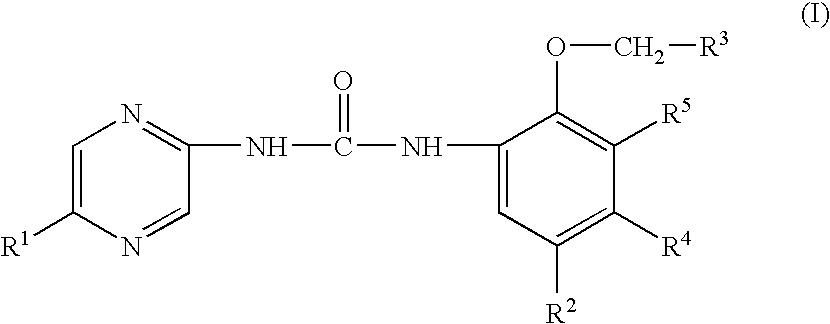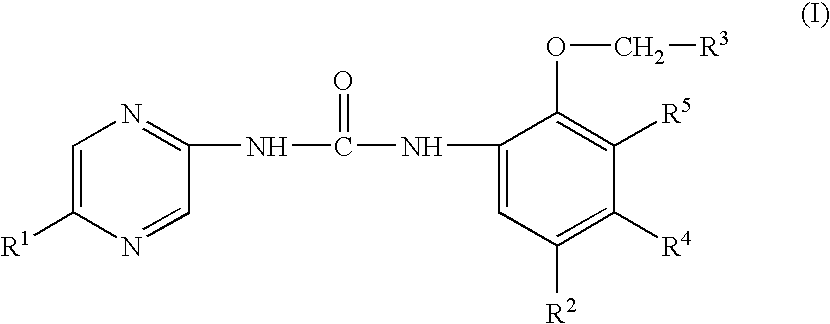Heteroaryl urea derivatives useful for inhibiting chk1
a heteroaryl urea and derivative technology, applied in the field of compounds, can solve the problems of affecting the treatment effect of aberrant cell proliferation, inappropriate cell proliferation, and unwanted repair,
- Summary
- Abstract
- Description
- Claims
- Application Information
AI Technical Summary
Benefits of technology
Problems solved by technology
Method used
Image
Examples
example 1
Determination of IC50 Values of Chk1 Inhibitors
[0252]Human Chk1 cDNA was identified and cloned as described previously in International Application Publication No. WO 99 / 11795, filed Sep. 4, 1998. A FLAG® tag was inserted in frame with the amino terminus of the full-length Chk1. The 5′ primer contains an EcoRI site, a Kozak sequence, and also encodes a FLAG® tag for affinity purification using the M2 Antibody (Sigma, St. Louis, Mo.). The 3′ primer contains a SalI site. The PCR-amplified fragment was cloned into pCI-Neo as an EcoRI-SalI fragment (Invitrogen, Carlsbad, Calif.), then subcloned as an EcoRI-NotI fragment into pFastBacI (Gibco-BRL, Bethesda, Md.). Recombinant baculovirus was prepared as described in the Gibco-BRL Bac-to-Bac manual and used to infect Sf-9 cells grown in CCM3 medium (HyClone Laboratories, Logan, Utah) for expression of FLAG®-tagged Chk1 protein.
[0253]FLAG®-tagged Chk1 was purified from frozen pellets of baculovirus-infected SF9 cells. Frozen cell pellets we...
example 2
Selectivity
[0255]Chk1 inhibitors of the present invention were tested for selectivity, with Chk1 as the comparison enzyme and the following protein kinases as comparator enzymes: Cdc2, Chk2, CTAK, EphA1, EphA2, Erk1, FGFR1, FGFR4, IR, JNK1, c-Kit, p38alpha, p38beta, p38delta, Ros, Rse, Rsk2, TrkA, TrkB, protein kinase A, protein kinase C, pp 60v-src, protein kinase B / Akt-1, p38MapK, p70S6K, calcium calmodulin-dependent kinase II, and ab1 tyrosine kinase.
[0256]The IC50 value of a compound versus Chk1 was measured as described above. The IC50 value of the compound against comparator enzymes was measured using the SelectSmart™ (MDS Pharma Servies, Bothell, Wash., USA) proprietary technology platform with either a modified ELISA procedure or fluorescence polarization. All inhibitors tested showed at least a 20-fold selectivity for Chk1 over the tested comparator enzymes.
[0257]Alternatively, assays for determining IC50 for each of these kinases have been previously described in the liter...
example 3
Cell-Based Assay for Determination of ECTFS Values of Chk1 Inhibitors
[0258]Cell-based potency of Chk1 inhibitors according to the invention was assessed by measuring the ability of the compound to sensitize HT29 human carcinoma cell line to gemcitabine. An average ECTFS value was derived following multiple experiments. Thus, a Chk1 inhibitor according to the invention was synthesized by methods described herein. The compound was dissolved in 100% dimethyl sulfoxide (DMSO) at a stock concentration of 10 mM and stored at −70° C. HT29 cells were obtained from the ATCC and maintained in growth medium consisting of RPMI containing 10% fetal calf serum (FCS), pen / strep, glutamine and other supplements. Gemcitabine hydrochloride was obtained from Qventas and dissolved in phosphate buffered saline (PBS) at 50 mM and stored at −20° C. 3H-thymidine was obtained from Perkin-Elmer.
[0259]HT29 cells were plated onto 96 well cell culture plates (Corning) at a density of 1.3×103 per well and allowe...
PUM
| Property | Measurement | Unit |
|---|---|---|
| reaction temperature | aaaaa | aaaaa |
| temperature | aaaaa | aaaaa |
| pH | aaaaa | aaaaa |
Abstract
Description
Claims
Application Information
 Login to View More
Login to View More - R&D
- Intellectual Property
- Life Sciences
- Materials
- Tech Scout
- Unparalleled Data Quality
- Higher Quality Content
- 60% Fewer Hallucinations
Browse by: Latest US Patents, China's latest patents, Technical Efficacy Thesaurus, Application Domain, Technology Topic, Popular Technical Reports.
© 2025 PatSnap. All rights reserved.Legal|Privacy policy|Modern Slavery Act Transparency Statement|Sitemap|About US| Contact US: help@patsnap.com



